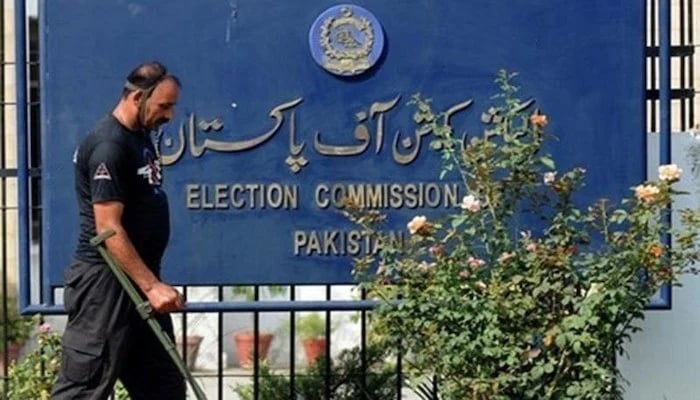ECP to meet final delimitation publication timeline: official
ECP official contended that commission could consider it but hastened to add that it might not be possible owing to diverse reasons
ISLAMABAD: The Election Commission of Pakistan will meet the timeline of publication of the final delimitation by November 30, said a senior official of the commission on Saturday.
When approached about Fafen’s findings that over one-fifth of the total constituencies of the national and four provincial assemblies recently delimited do not comply with Section 20(3) of the Elections Act, 2017, exceeding the legal limit of 10 percent variation in the population, he said the forum was available and arrangements in place to deal with the issue.
To a proposal floated by the network that the hearings of representations might be arranged at the provincial level, the ECP official contended that the commission could consider it but hastened to add that it might not be possible owing to diverse reasons.
According to the Election Commission’s preliminary delimitation report, the quota for each National Assembly (NA) constituency for Khyber Pakhtunkhwa was calculated at 907,913, Islamabad Capital Territory 787,954, Punjab 905,595, Sindh 913,052 and Balochistan 930,900.
However, contrary to these quotas, there are glaring instances of constituencies, proposed to be delimited far beyond, like the largest proposed NA constituency in Punjab is NA-49 Attock-I with a population of 1,126,142, followed by NA-50-II with 104,4281 persons in the district, whereas the smallest constituency, NA-61 Jhelum-II consists of a population of 690,683 and its other constituency Jhelum-I comprises 691,625 people. Some other constituencies in Punjab, having population size of more than one million include NA-181 Layyah I, NA-182 Layyah II, NA-139 Pakpattan I, NA-140 Pakpattan II, NA-141 Sahiwal I, NA-77, Gujranwala-I, Gujranwala-11, NA-79 Gujranwala III, NA-80 Gujranwala IV, NA-81 Gujranwala-cum-Hafizabad and NA-92 Bhakkar, Jhang-II and Jhang-III.
The largest NA constituency in Khyber Pakhtunkhwa, NA-39 Bannu has a population of 1,357,890, whereas the smallest constituency, NA-1 Chitral Upper-cum-Chitral Lower has a population of 515,935 and NA-13 (Battagram) comprises of 554,133 people. While Malakand has a population size of 826,250, NA-8, Bajaur comprises 128,760 persons and Kohat 123,4661, some other constituencies also consist of over a million persons. On the lower side, NA-40 North Waziristan comprises 693,332 and NA-16 Abbotabad-1 699,311 persons. In Sindh, Sanghar-I, NA-209 and Sanghar-II, NA-210 have population sizes of 1,172,516 and 1,135,949 respectively. Likewise, Umerkot NA-213 consists of 1,159,831 persons and on the lower side, Tando Muhammad Khan, NA-221, comprises 726,119 and Hyderabad-III, NA-220 784,534. In Balochistan, there are only three NA constituencies, having over a million population and these include NA-255 Sohbatpur-cum-Jaffarabad-cum-Usta Muhammad-cum-Nasirabad with a population of 1,124,567, followed by NA-260, Chagai-cum-Nushki-cum-Kharan-cum-Washuk with 1,040,001 and NA-265, Pishin-cum-Ziarat with a population size of 1,025,017. However, in contrast to them, NA-261 Quetta-I has a population of 799,886 and Quetta-II, NA-263, 8,219,950.
-
 Prince William, Kate Middleton’s Frustrations Rise As Divorce Rumors Finally Get Answered?
Prince William, Kate Middleton’s Frustrations Rise As Divorce Rumors Finally Get Answered? -
 Charlie Puth Gets Real About Super Bowl Anthem Role
Charlie Puth Gets Real About Super Bowl Anthem Role -
 Kim Kardashian Explains Why She Rarely Sees Jonathan Cheban Now
Kim Kardashian Explains Why She Rarely Sees Jonathan Cheban Now -
 Meghan Markle Spilt ‘third Date’ Magic With Prince Harry
Meghan Markle Spilt ‘third Date’ Magic With Prince Harry -
 When Will 'Jujutsu Kaisen' Season 3 Ep 4 Come Out?
When Will 'Jujutsu Kaisen' Season 3 Ep 4 Come Out? -
 Prince William Lays Down The Law As Andrew’s Exile Nears: ‘Even If He Spirals Out Of Control’
Prince William Lays Down The Law As Andrew’s Exile Nears: ‘Even If He Spirals Out Of Control’ -
 Phil Collins Shares New Details About His Long-running Health Struggles
Phil Collins Shares New Details About His Long-running Health Struggles -
 Paris Hilton Reveals Sweet Sibling Dynamic Between Phoenix, London
Paris Hilton Reveals Sweet Sibling Dynamic Between Phoenix, London -
 Chris Pratt Gets Honest About Panic Around AI
Chris Pratt Gets Honest About Panic Around AI -
 Jennifer Garner Shares Rare Parenting Insight After Ex Ben Affleck's Remark: 'I've Been There'
Jennifer Garner Shares Rare Parenting Insight After Ex Ben Affleck's Remark: 'I've Been There' -
 King Charles Exits London Without Seeing Prince Harry
King Charles Exits London Without Seeing Prince Harry -
 Kim Kardashian Praises Taylor Swift Despite Past Feud: 'Great Artist'
Kim Kardashian Praises Taylor Swift Despite Past Feud: 'Great Artist' -
 Stefon Diggs Pays Tribute To Cardi B: ‘I Don’t Talk Too Much But’
Stefon Diggs Pays Tribute To Cardi B: ‘I Don’t Talk Too Much But’ -
 Sarah Ferguson Plans To Sell Princess Diana ‘private Letters?’
Sarah Ferguson Plans To Sell Princess Diana ‘private Letters?’ -
 Kim Kardashian Pushes Back On Criticism Over North West’s Style Statements
Kim Kardashian Pushes Back On Criticism Over North West’s Style Statements -
 Meghan Trainor's Kids 'over The Moon' After Welcoming Baby Mikey
Meghan Trainor's Kids 'over The Moon' After Welcoming Baby Mikey




